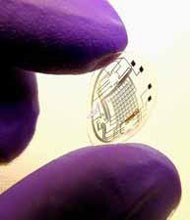Feast Your Eyes on This

By Ashley Peterson and Gwen Myslinski
For 100 million people around the world, retinal diseases have been the cause of partial or complete blindness, and most of these conditions are degenerative and passed down from one generation to another. While at the present time there is no cure for this type of gradual blindness, several researchers are working on solutions that will provide many individuals with improved vision and offer hope that their future generations won't have to experience this inevitable and debilitating journey from light to darkness.
Bionic ...
Last spring, European regulators approved the first commercially-available bionic eye. The Argus II is a video camera built into a pair of glasses that wirelessly transmits a signal to an implant located behind the patient's retina. It allows the recipient to see a 60-pixel image, which means distinguishing between light from dark, localizing large objects, recognizing faces, reading large print and independently interacting with his surroundings. It's not high-definition, but it's certainly a huge difference.
Though to make a significant impact, Richard Taylor, a University of Oregon physicist and vision researcher, says, "Engineers and neuroscientists will have to come up with something much more sophisticated than an implanted camera."
Too Artificial
As with all technology, researchers are working on the latest and greatest: artificial retinas that don't require an external camera. "Instead, the photons will strike light-sensitive arrays inside the eye itself," according to Carl Zimmer from Discover Magazine. One company even has created experimental prototypes containing 5,000 light sensors.
Overall, this new technology is still in the infancy stage, and researchers are trying to answer several questions:
- According to Zimmer's article, one of these questions is: "Should the electrodes be positioned less like a grid and more like a set of psychedelic snowflakes with branches upon branches filling the retina in swirling patterns?"
- How many electrodes should the retina contain, and can the brain process the information?
- Is it possible to overcome the mismatch between regular electrodes and irregular neurons in the brain?
While scientists still have a lot of progress to make toward completely restoring lost vision, they certainly have helped some to "see the light" in recent years.
Classroom Discussion
- How do the human eye and retina work to enable sight? How might a scientist replicate this process to help individuals who have lost their sight due to inherited disease?
- If you were a scientist working to improve vision loss, what advancements would you hope to make for the next generation affected by retinal disease?